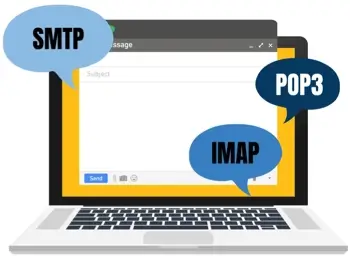What Are Email Protocols? An Email Protocol Guide
Each email you send follows a specific ruleset to reach the recipient correctly. The set of rules that governs email communication is what is referred to as email protocols. These secure email protocols guide email messages from one server to another. In this article, learn what an email protocol is and how the three main protocols - SMTP, POP3, and IMAP - function.
What is an email protocol?
An email protocol is explained as a set of rules governing how email messages are transmitted, received, and managed over the Internet. It defines the structure emails must follow to ensure they arrive in the recipient’s inbox just as they were sent.
These rules can include instructions indicating whether to receive an email or send an error notification.
Email protocols ensure that message sharing is universal. They allow emails to be sent and received reliably, regardless of the type of device, server, or email app being used.
For instance, you can send an email from Gmail to a friend using Outlook without any compatibility issues. Even though you're using different email services, the email clients and email servers use the standards defined by email protocols to ensure your message lands seamlessly in your recipient’s inbox.
Additionally, email protocols outline email formatting and specify the processes and type of connection needed between email systems to make everything work smoothly.
The protocols work with tools like email authentication, spam checks, and blacklists to achieve reliable delivery. In essence, protocols are the driving forces that help direct emails straight to recipients' inboxes.
SMTP, IMAP, and POP3 are key protocols for end-to-end delivery. SMTP sends email messages while the latter two retrieve emails.
How email protocols work
When you press “send” on an email, whether for a marketing campaign or a personal note, you don’t think about how it will arrive. Your main concern is that it reaches the recipient’s inbox successfully.

However, delivering the email and having it reach the inbox relies on the underlying email infrastructure. Email protocols create the link needed for messages to travel between the transferring parties.
Email forwarding includes three main parts: the sender, the mail server, and the recipient. First, the sender composes and sends an email, which is then routed to a mail server. The server acts as a central hub, receiving the email, processing it, and preparing it for delivery.
Finally, the server sends the email to the recipient’s inbox. Protocols manage each part of this journey so that the email flows securely from the sender to the recipient.
What are the 3 email protocols?
Three major email protocols involved in the exchange of emails are SMTP, IMAP, and POP3.
SMTP (Simple Mail Transfer Protocol)
SMTP is a standard protocol for sending email messages through the Internet. To use SMTP, you need three main elements: a network port, the SMTP server, and login credentials for the sender.
These settings allow the sender’s email client and the recipient’s server to “talk” through a series of SMTP commands. Each command tells the servers how to handle the email’s journey. Frequently used commands in SMTP are HELO, MAIL FROM, and RCPT TO.
When you send an email, your email program connects directly to an SMTP server provided by your email provider. The process starts when the program uses your login details to verify your identity with the server. Once authenticated, the SMTP server takes your message and delivers it to the recipient’s server.
The SMTP email protocol splits the email into smaller data packets, making it easier to send across the Internet. These packets travel from your program to the SMTP server as it connects with the recipient’s server. The SMTP server checks that the link is valid and secure, exchanging information with the recipient’s server to confirm delivery.
The recipient’s server then reassembles the packets into the original message and places them in the recipient's inbox. SMTP has built-in filters to screen for spam, limiting how many emails can be sent simultaneously to prevent spam.
SMTP ports
Simple Mail Transfer Protocol uses three main ports, each designed with a specific level of security for sending emails. These ports ensure messages are delivered securely or, if necessary, as plaintext.
- Port 25. It’s the original SMTP port that sends messages without encryption by default. But if a server supports TLS, port 25 can send emails with encryption. Due to security concerns, many Internet service providers restrict this port.
- Port 2525. Often used as an alternative to port 25, this port supports encryption through TLS and is a good choice when port 25 is unavailable.
- Port 587. This is the most secure SMTP port, officially registered with the Internet Assigned Numbers Authority (IANA). Port 587 uses TLS encryption by default, but emails will be sent as plaintext if the server does not support TLS.
IMAP (Internet Message Access Protocol)
IMAP is a protocol for retrieving messages from a mail server. It allows you to access messages directly on the server without downloading them.
When you use an email program with the IMAP email protocol, it connects to the mail server to sync your emails and account information. This sync process does more than just retrieve new emails; it also updates any changes you make.
For example, if you read, delete, or move emails into folders on one device, these actions are instantly saved on the server. Any other device connected to your account will then show the same updates. IMAP keeps your email experience consistent, letting you access the latest version of your inbox from any device.
Similar to SMTP, IMAP uses specific ports but operates on different ones. The standard IMAP port is 153. When IMAP is secured with TLS or SSL encryption, it’s called IMAPS and uses port 993. Email services and apps, such as Outlook and Gmail, use IMAP.
POP3 (Post Office Protocol version 3)
POP3 is an email protocol for downloading emails from a mail server to a local device. Unlike IMAP, which keeps messages on the server, POP3 downloads emails and deletes them from the server afterward by default.
The biggest perk of POP3 is that it allows you to reach emails even when you’re offline. It comes in handy when you have an unstable Internet connection. POP3 works well if you only need to access email from one device or prefer to store emails locally.
The POP3 email protocol is efficient but lacks the flexibility to keep emails in sync across many devices. Emails are delivered as soon as the user connects to the Internet.
Similar to SMTP, POP3 understands a straightforward set of text commands. Some commonly used commands include USER, PASS, RETR, and more.
POP3 uses two main ports:
- Port 101, which is the standard default port for POP3
- Port 995, which is a more secure, encrypted port option
Port 995 is generally the better choice today due to its added security features, which help protect your email data.
How email protocols work together
SMTP, IMAP, and POP3 work together to handle the entire cycle of email communication. SMTP is the backbone of email transmission. Email clients like Yahoo Mail, Apple Mail, Outlook, and Gmail can send messages over TCP/IP networks.
IMAP and POP3 manage how the recipient stores and accesses emails. SMTP sends the email out, IMAP enables multi-device access and synchronization, and POP3 provides a local, offline storage option.
These protocols complement each other to create a complete system for seamless email communication across various platforms and devices.
Email protocol security
We can’t talk about security when sending and receiving emails without discussing email encryption. Email encryption encodes the email’s content so only the intended recipient can decode and read it. The idea is to protect sensitive information against security threats.
The two main methods of email encryption are SSL (Secure Sockets Layer) and TLS (Transport Layer Security). SSL, developed in 1995, was one of the first protocols for securing digital communication. It starts with a “handshake” between devices to establish a secure connection.
The handshake verifies both devices and creates a digital signature that confirms the data remains unaltered throughout the transfer. SSL became widely used to secure emails and websites by adding a layer of protection to online data exchanges.
In 1999, TLS emerged as an upgraded version of SSL with better encryption and security features. Like SSL, TLS begins with a handshake to verify the identities of both devices. TLS enhances security through stronger encryption methods that make unauthorized access more difficult. It creates secure records for each data packet to keep email content intact throughout its journey.
SSL and TLS together created the foundation of email security protocols. TLS is now the standard because it offers stronger protection. These protocols operate behind the scenes each time you send an encrypted email to keep digital communication secure.
How to pick an email protocol for your business
Picking the proper email protocol for your business depends on a few key points. Though only one protocol, SMTP, handles sending emails, you have two choices for receiving them: IMAP and POP3. Each option serves different needs. Consider the following factors when deciding between IMAP and POP3.
- Business size. For smaller businesses, IMAP is often the better choice. IMAP keeps emails on the server so they remain accessible across all devices. Small teams don’t fill up server storage as quickly, so this approach works well in the early days. IMAP also lets employees access duplicate emails and supports effective teamwork.
- Software compatibility. Think about compatibility with email marketing tools as well. Some tools and servers are optimized for IMAP, while others favor POP3. The protocols supported by your software may ultimately decide which option you choose.
- Email volume. Consider email volume, too. If your business sends and receives high volumes, POP3 may be more efficient. It downloads emails to your device and frees up server space. SMTP port 587 is the most up-to-date for outgoing emails. It also adds encryption for safe delivery, especially as email volume rises.
- Hosting company. Your email host matters a lot, so consider it as well. Many hosts support all three protocols, but some favor specific options. Based on your setup, you may find IMAP or POP3 a better fit.
You don’t have to pick just one protocol. Small businesses can use both IMAP and POP3 closely for added flexibility. This setup combines the benefits of server-side storage and local downloads.
Frequently asked questions
Why is SMTP called push protocol?
SMTP is a push protocol because it actively sends outgoing emails from the sender’s server to the recipient’s server. The recipient’s server doesn’t have to ask for the email; instead, SMTP automatically “pushes” it to the destination server.
What are the default port numbers for SMTP, IMAP, and POP3?
The default port number for SMTP is 587, 143 for IMAP, and 110 for POP3. These ports are standard for handling outgoing and incoming emails across different email clients and servers.
How can I check if my email authentication is set up correctly?
Start by reviewing your email settings. You can also look at the message headers in email services like Gmail. Open an email, find the section labeled "Authentication Results," and check for "dkim=pass" or "spf=pass." If you see these, it means your email authentication is working as expected.

